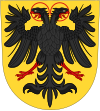
Back البرلمان الامبراطوري Arabic Reyxstaq (Müqəddəs Roma imperiyası) Azerbaijani Рэйхстаг (Свяшчэнная Рымская імперыя) Byelorussian Райхстаг (институция) Bulgarian Imperijalna dijeta (Sveto Rimsko Carstvo) BS Dieta Imperial Catalan Říšský sněm (Svatá říše římská) Czech Rigsdagen (Det tysk-romerske Rige) Danish Reichstag (Heiliges Römisches Reich) German Imperia dieto Esperanto
Imperial Diet Dieta Imperii (Latin) Reichstag (German) | |
|---|---|
| Deliberative body of the Holy Roman Empire | |
 | |
| History | |
| Founded | 803 |
| Disbanded | 1806 |
| Succeeded by | Diet of the Confederation (Confederation of the Rhine) |

The Imperial Diet (Latin: Dieta Imperii or Comitium Imperiale; German: Reichstag) was the deliberative body of the Holy Roman Empire. It was not a legislative body in the contemporary sense; its members envisioned it more like a central forum where it was more important to negotiate than to decide.[1]
Its members were the Imperial Estates, divided into three colleges. The diet as a permanent, regularized institution evolved from the Hoftage (court assemblies) of the Middle Ages. From 1663 until the end of the empire in 1806, it was in permanent session at Regensburg.
All Imperial Estates enjoyed immediacy and, therefore, they had no authority above them besides the Holy Roman Emperor himself. While all the estates were entitled to a seat and vote, only the higher temporal and spiritual princes of the College of Princes enjoyed an individual vote (Virilstimme), while lesser estates such as imperial counts and imperial abbots, were merely entitled to a collective vote (Kuriatstimme) within their particular bench (Curia), as did the free imperial cities belonging to the College of Towns.[2]
The right to vote rested essentially on a territorial entitlement, with the result that when a given prince acquired new territories through inheritance or otherwise, he also acquired their voting rights in the diet.[3] In general, members did not attend the permanent diet at Regensburg, but sent representatives instead. The late imperial diet was in effect a permanent meeting of ambassadors between the estates.
- ^ Klaus Malettke, Les relations entre la France et le Saint-Empire au XVIIe siècle, Honoré Champion, Paris, 2001, p. 22.
- ^ Gagliardo, John G. (1980). Reich and Nation. The Holy Roman Empire as Idea and Reality, 1763–1806. Indiana University Press. pp. 22–23. ISBN 978-0-2531-6773-6. OL 4401178M.
- ^ Gagliardo 1980, pp. 22–23.